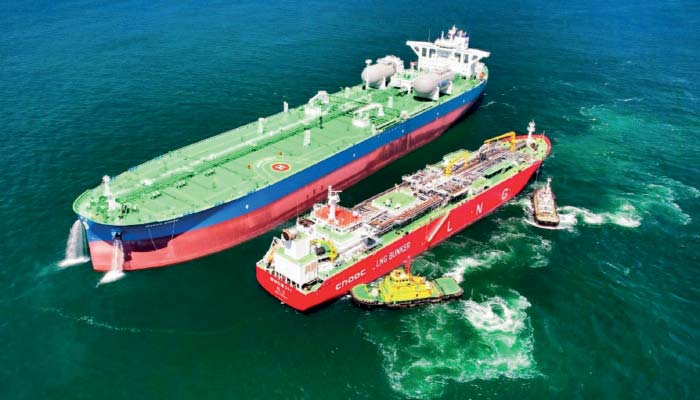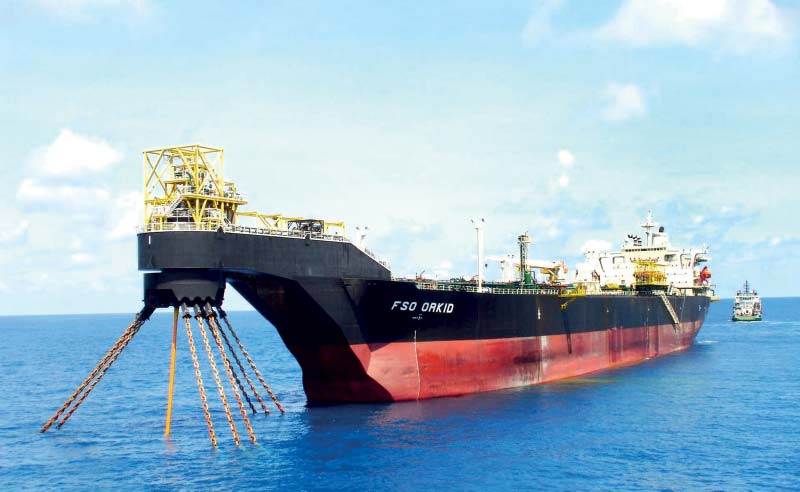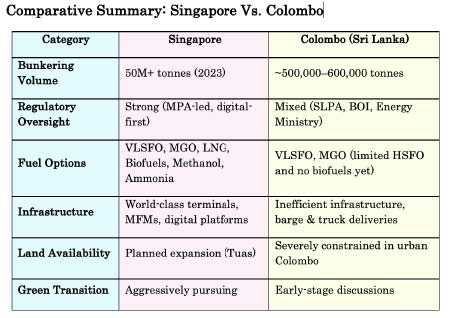Sunday Dec 14, 2025
Sunday Dec 14, 2025
Monday, 11 August 2025 02:14 - - {{hitsCtrl.values.hits}}


 A strategic crossroads with untapped potential
A strategic crossroads with untapped potential
With global shipping lanes intersecting just south of its coastline, Sri Lanka holds a pivotal location in the Indian Ocean. Despite this geographic advantage, Sri Lanka’s marine fuel (bunkering) sector remains underdeveloped. The country currently handles an estimated 1.2 to 1.5 million metric tonnes of marine fuel annually, a fraction of its potential. A transformation in policy, regulation, and technology modelled on Singapore’s globally admired reforms could change that.
Singapore: From scandal to global benchmark
Singapore’s journey to becoming the world’s top bunkering hub was not without challenges. In the early 2010s, the market was plagued by widespread malpractice: bunker suppliers delivered less fuel than invoiced, manipulated flow meters, and falsified delivery notes. This eroded trust, discouraged premium clients, and made enforcement difficult.
In 2017, the Maritime and Port Authority (MPA) of Singapore made a bold move: it mandated the use of certified Mass Flow Meters (MFMs) on all fuel oil deliveries. These meters provided real-time, tamper-proof data that verified exact quantities delivered. Coupled with auditing, digital documentation, and strict licensing rules, Singapore restored credibility.
The results were impressive. Singapore’s bunker fuel sales rose from 47.4 million metric tonnes in 2016 (pre-MFM) to over 50.64 million metric tonnes by 2023 an 8.4% increase despite global disruptions. The transparency brought high-value clients back, including naval fleets, LNG vessels, and green shipping alliances.
Sri Lanka: A sleeping giant in the Indian Ocean
Amid limited land availability near the Port of Colombo, this article proposes a bold, timely strategy: the promotion of offshore bunkering using Floating Storage and Offloading Unit (FSO) and multi-fuel delivery platforms. This approach can help Colombo leapfrog traditional infrastructure constraints and position itself as a flexible, green-ready, and investor-friendly bunkering hub.
Sri Lanka has long benefited from its prime location on the East–West maritime corridor. However, despite this geographic advantage, its bunkering industry has lagged behind due to:
The Port of Hambantota, developed with Chinese support, has significant bunkering infrastructure (14 tanks; ~80,000 m³), but demand remains low due to limited ship calls.
Conversely, the Port of Colombo, Sri Lanka’s busiest handles over 7 million TEUs annually and remains the most commercially viable location to increase and improve bunkering services. Yet the scarcity of land for new storage tanks and pipelines limits the growth of onshore fuel supply capacity.
 Opportunity: Offshore bunkering via floating storage
Opportunity: Offshore bunkering via floating storage
Given Colombo’s real estate constraints and growing marine traffic, offshore bunkering using FSOs and multi-fuel delivery barges presents a fast, cost-efficient solution. Several global bunkering hubs (e.g., Fujairah, Port Klang, Malta) successfully use this model.
Key advantages of offshore bunkering
Offshore bunkering presents a transformative opportunity for Sri Lanka to modernise its maritime fuel supply chain while minimising environmental and land-use concerns. One of the primary advantages is the negligible requirement for land-based infrastructure and there is no need for extensive onshore tank farms or pipelines, which are often costly and land-intensive. Instead, floating storage units such as FSOs (Floating Storage and Offloading units) can be deployed offshore, thereby preserving valuable port-side land for other commercial uses.
In terms of implementation, offshore bunkering offers rapid deployment capabilities. FSOs can be positioned and made operational within a relatively short time frame of 6 to 12 months, significantly faster than the timelines associated with constructing permanent infrastructure. This model also offers exceptional flexibility in fuel offerings, enabling the simultaneous supply of various marine fuels, including Very Low Sulphur Fuel Oil (VLSFO), Marine Gas Oil (MGO), Liquefied Natural Gas (LNG), and emerging biofuels. As market demand evolves, the offshore model allows for seamless scalability and additional FSOs can be introduced without disrupting existing operations. Importantly, the model is also cost-efficient, requiring significantly lower capital expenditure (CapEx) compared to traditional onshore bunkering terminals.
Recommended operational model for the Port of Colombo
To implement offshore bunkering successfully at the Port of Colombo, Sri Lanka should consider a structured and forward-looking model. The first step involves creating a Regulatory Sandbox specifically for offshore bunkering under the jurisdiction of the Ministry of Energy (MOE) and the Board of Investment (BOI), or preferably through a newly proposed independent energy regulatory authority similar to the Public Utilities Commission of Sri Lanka (PUCSL). This framework should provide simplified and expedited approvals for floating storage operations and fuel deliveries, with well-defined customs, tax, and fuel quality compliance standards. It must also made mandatory to use Electronic Bunker Delivery Notes (E-BDN) and Mass Flow Meters (MFM) to ensure transparency and reduce the risk of fuel fraud.
Secondly, Sri Lanka should invite Public-Private Partnerships (PPPs) through competitive bidding to support key aspects of the project. This would include the deployment of FSOs near the Colombo anchorage, conversion of retired tankers into floating fuel depots, and the development of multi-fuel blending and delivery capabilities using bunker barges and specialised tankers. Such an approach would bring in global technical expertise, reduce government burden, and attract strategic investment into the maritime sector.
Promoting green fuel transition and strategic anchoring
The future of marine energy lies in decarbonisation, and Sri Lanka should proactively encourage green fuel capabilities within its offshore bunkering ecosystem. This includes allowing licensed FSOs and fuel companies to import and supply alternative fuels such as biofuels, low-carbon LNG, and trial-grade methanol. Collaborations should be established with energy transition partners from UAE, India, and Singapore. Moreover, Sri Lanka can tap into international climate finance mechanisms to develop necessary infrastructure for fuel switching, thus enhancing the sustainability of the maritime industry while securing foreign funding.
To facilitate safe and efficient operations, a Strategic Floating Anchorage Zone should be designated and geo-fenced within weather-protected waters adjacent to the outer harbour or Western Container Terminal of Colombo Port. This zone would support safe mooring of floating storage units and enable barge-to-ship and ship-to-ship fuel transfers. It must be regulated under strict inspection, monitoring, and safety protocols to ensure environmental and navigational safety.
Policy blueprint for national implementation
For Sri Lanka to emulate global leaders like Singapore in marine fuel services, it must adopt a bold and coordinated policy reform agenda. A key reform is the mandatory installation of Mass Flow Meters (MFMs) across all bunkering points in Colombo, Hambantota, and Trincomalee to standardise accuracy and curb malpractice. A centralised, real-time bunker delivery monitoring system, governed by the Ministry of Energy or an independent regulator, should be developed to oversee nationwide operations.
Additionally, Sri Lanka must adopt blockchain-based digital documentation for bunkering, including delivery notes, invoices, and audit logs to ensure traceability and reduce administrative friction. Transparent licensing frameworks, routine operational audits, and strict penalties for violations must be embedded into the regulatory regime. The government should also partner with global maritime and classification societies to validate and certify MFM data integrity.
To further accelerate adoption, tax incentives and port fee discounts should be offered to early movers who invest in green and digital bunkering solutions—whether through onshore terminals or offshore floating infrastructure. This comprehensive and adaptive policy environment will position Sri Lanka as a credible, competitive, and compliant maritime fuel hub in the Indian Ocean.
How Sri Lanka could grow a 6 million tonne market by 2035
If Sri Lanka enacts these reforms over the next 2–3 years, its bunker volumes could quadruple by 2035. Colombo’s lower anchorage fees, proximity to international routes, and deep-water terminals already offer an operational edge. Hambantota, with room for onshore LNG and green fuel facilities, and Colombo unlocking its offshore bunkering potential, Sri Lanka could become a multi-fuel hub for transoceanic shipping.
A clear regulatory regime, backed by digital transparency and industry trust, could position Sri Lanka as a reliable alternative to congested and higher-cost markets like Mumbai or Fujairah.
Key risks to Sri Lanka’s energy and maritime sector, if ignored
Conclusion: From constraint to competitive edge
Sri Lanka stands at a crossroad. Colombo Port has the volume, the visibility, and the vessel traffic. What it lacks is land, and it can be turned into an advantage through smart, floating bunkering solutions.
By encouraging offshore bunkering with low CapEx, rapid deployment, and green fuel readiness, Colombo can position itself as the Indian Ocean’s agile energy outpost, a smart alternative to regional giants like Singapore and Fujairah. This move aligns with global shipping decarbonisation, investor appetite for asset-light logistics models, and Sri Lanka’s goal of becoming a regional maritime hub.
Sri Lanka’s potential to lead in South Asia’s bunkering market is both real and attainable. However, success depends on embracing a regulatory and technological shift similar to Singapore’s transformation. Through transparency, real-time monitoring, trust, and opening the industry for competition and investments into new products and services, Sri Lanka can not only boost its maritime economy, but also elevate its standing as a responsible and globally integrated port nation.
Singapore’s success proves that reform, not just geography, determines bunkering dominance. By prioritising the timely intervention, real-time monitoring, fair trade, and digital standards, Sri Lanka has a real chance to define itself as South Asia’s most efficient, compliant, and future-ready marine fuel hub.
References:
1. Maritime and Port Authority of Singapore (2024). ‘Annual Bunkering Statistics’. https://www.mpa.gov.sg
2. SLPA (2023). ‘Port Performance and Trade Overview’. https://www.slpa.lk
3. IBIA (2023). ‘State of the Global Bunker Market’. International Bunker Industry Association. https://ibia.net
(The writer is a former Bureaucrat, ADB Registered Consultant, and Board Member, Maritime and Energy Sectors.)